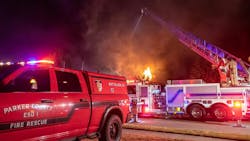It is easy to get nostalgic looking at historic pumpers but compared to the apparatus being produced today, even fire apparatus a few decades old are missing some major technological advancements. In a connected world, the most recognizable vehicle on the road is quickly ramping up options to bring information to responders faster and better than before. Departments that want to provide the best service are leveraging technology upgrades to improve connection stability and redundancy, adding flexible options for crews to access information, investing in built-in information centers, providing proactive and intelligent options for intersection controls along with bass siren tech, and using services that establish real-time updates on the vehicle’s performance and location.
Get connected: Wi-Fi and beyond
From the inception of radio and eventually internet-based services, fire apparatus need to have the best connections. FirstNet-powered solutions have done a great job of providing priority access to the cell networks however, spotty signals and even fire stations that block cell signals often lead to crew frustrations as the computer searches for a signal.
A key piece of equipment that reduces these frustrations is a Cradlepoint Router. Ranging in pricing and options, these routers have robust abilities like being able to seamlessly switch between internet sources (station Wi-Fi public Wi-Fi and cell service), use multiple cell sources, and provide precise GPS tracking. Compared to the old school options of a hot spot or GPS puck, Cradlepoint Routers are more durable, depending on the antenna, which can broadcast signals up to 100 yards away, and have options for nearly every vehicle setup.
The ability to hot-switch between internet sources proves to be the best feature as it keeps the crew connected with the CAD, allows for silent dispatch options (status buttons only) without interruption, and creates a truly reliable network connection.
Mobile Data Terminal and tablets
Mobile Data Terminals (MDTs) are considered a staple in the modern fire service, so much so that many manufacturers create lowered dash options and pre-mounted hardware for MDTs that do not block the driver’s view.
Compared to even 10 years ago, there are MDT solutions that can fit every apparatus configuration and department budget. Larger laptops, touchscreens, multi-screen command consoles, tablets of all sizes, various manufactures, and operating systems… today’s fire apparatus have no excuse to not have some sort of connection. With so many software platforms available to the fire service, these MDTs offer access to preplans, drone broadcasting, electronic command boards, firefighter tracking solutions, digital reporting, and air management telemetric programs. Smarter dispatch centers can share live video of an emergency scene as responders are enroute.
Essentially, without an MDT, the modern responder is missing key information to make better decisions which in turn would provide better outcomes.
Built-in information centers
Some of the first electronic sensors were added to the fire apparatus to help identify if a compartment door was left open but compared to the blinking red light today’s apparatus can provide so much more information. Built-in information centers are available in nearly every model of apparatus and provide the driver/officer access to mounted camera systems, light/emergency lights/siren controls, apparatus system information, and even on-board diagnostics.
If the viewer wants to see who is wearing their seatbelts, tracks the driver’s speed, or identify if any compartments are open, these built-in information centers are a great option.
Preemption systems and bass sirens
The earliest pre-emption systems relied on a blinking light, infrared signal, or the sound of a particular siren to change an intersection light to green for an approaching apparatus however today, these systems are more robust. The best systems are connected knowing the path of travel for the apparatus to ensure it has cleared out the traffic well ahead of the apparatus’ arrival, adjusting if the driver chooses to make a turn that was not anticipated on the established route. The smart systems also offer varying levels of pre-emption to help improve the efficiency of other services to include snowplows, buses, and garbage collection.
While pre-emption makes traversing intersections during emergency travel safer, they do not address soundproof cars or pedestrians with noise cancelling earbuds which is why it is important to investigate bass siren technology. While there are many versions of this type of siren, the concept is the same. Lower frequency signals have a better chance to penetrate the sound proofing and noise cancellation technology. The best options are truly a siren that can be felt.
If you add both technologies, the ability to navigate to an emergency scene is safer.
Tracking and Telematics
While some crews may not appreciate the concept of “big brother” watching everything, modern fleets often have great tracking and telematics. The best organizations fully leverage these technologies to automate everything from marking an apparatus enroute, out in the area, or back in quarters via geo-fencing to reducing the workload during apparatus checkouts.
Commercial fleets have long used these technologies to improve preventative maintenance programs and hold drivers accountable for their driving behaviors but as they enter the fire service, they provide vital tools for analyzing scene operations. What route did the driver take to arrive faster than expected? Was everyone wearing their seatbelt while the vehicle was in motion? Did the apparatus just cross a mileage or operation hour threshold that triggers a preventative maintenance task?
These systems can report outside of the apparatus and help decision makers understand what is happening with the apparatus and where it is/has been. The true power comes after a particularly rough call where you can rebuild the entire response from dispatch till the apparatus is safely parked at the station again. Knowing each apparatus’ route and speed, truly seeing the arrival order, and in the event of an equipment failure or accident, having access to speed, direction, and rider information is invaluable.
Conclusion
Fire apparatus manufacturers are adding additional built-in technology. However, if departments look to keep up with the times, they need to invest in some tech upgrades. Starting with better connectivity, the other options bring information to the crew, improve the safety of emergency responses, and can help automate care and maintenance of one of the most expensive pieces of equipment we use. The most proactive chiefs look to leverage technology to help their crews, these are relatively small expenditures compared to benefits they provide.
About the Author

Jason Moore
Jason Moore is a 23-year veteran of the fire service who began his career with the U.S. Air Force as a fire protection specialist. Moore is involved with the International Association of Fire Chiefs’ Technology Council and is a founding member/associate director of the Indiana University Crisis Technologies Innovation Lab. He delivered presentations on implementing technology, using technology for community risk reduction and best practices to justify funding for innovative programs. Moore was the keynote speaker at FireFusion 2024.

